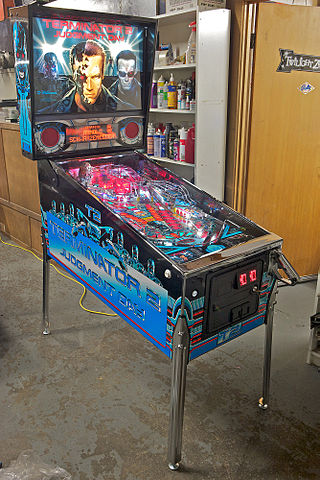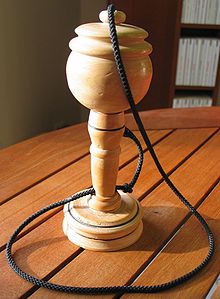
Cue sports are a wide variety of games of skill played with a cue, which is used to strike billiard balls and thereby cause them to move around a cloth-covered table bounded by elastic bumpers known as cushions. Cue sports are also collectively referred to as billiards, though this term has more specific connotations in some varieties of English.

Tarot is a pack of playing cards, used from at least the mid-15th century in various parts of Europe to play card games such as Tarocchini. From their Italian roots, tarot-playing cards spread to most of Europe, evolving into a family of games that includes German Grosstarok and modern games such as French Tarot and Austrian Königrufen. In the late 18th century French occultists made elaborate, but unsubstantiated, claims about their history and meaning, leading to the emergence of custom decks for use in divination via tarot card reading and cartomancy. Thus, there are two distinct types of tarot packs in circulation: those used for card games and those used for divination. However, some older patterns, such as the Tarot de Marseille, originally intended for playing card games, are also used for cartomancy.

Pinball games are a family of games in which a ball is propelled into a specially designed table where it bounces off various obstacles, scoring points either en route or when it comes to rest. Historically the board was studded with nails called 'pins' and had hollows or pockets which scored points if the ball came to rest in them. Today, pinball is most commonly an arcade game in which the ball is fired into a specially designed cabinet known as a pinball machine, hitting various lights, bumpers, ramps, and other targets depending on its design.

Pool is a series of cue sports played on a billiard table. The table has six pockets along the rails, into which balls are shot. Of the many different pool games, the most popular include: eight-ball, blackball, nine-ball, ten-ball, seven-ball, straight pool, one-pocket, and bank pool. Eight-ball is the most frequently played discipline of pool, and it is often thought of as synonymous with "pool".

Playing cards have been in Italy since the late 14th century. Until the mid 19th century, Italy was composed of many smaller independent states which led to the development of various regional patterns of playing cards; "Italian suited cards" normally only refer to cards originating from northeastern Italy around the former Republic of Venice, which are largely confined to northern Italy, parts of Switzerland, Dalmatia and southern Montenegro. Other parts of Italy traditionally use traditional local variants of Spanish suits, French suits or German suits.

A perfect game is the highest score possible in a game of bowling, achieved by scoring a strike with every throw. In bowling games that use 10 pins, such as ten-pin bowling, candlepin bowling, and duckpin bowling, the highest possible score is 300, achieved by bowling 12 strikes in a row in a traditional single game: one strike in each of the first nine frames, and three more in the tenth frame.

The kendama is a traditional Japanese skill toy. It consists of a handle (ken), a pair of cups (sarado), and a ball (tama) that are all connected together by a string. On one end of the ken is a cup, while the other end of ken is narrowed down, forming a spike (kensaki) that fits into the hole (ana) of the tama. The kendama is the Japanese version of the classic cup-and-ball game, and is also a variant of the French cup-and-ball game bilboquet. Kendama can be held in different grips, and many tricks and combinations can be performed. The game is played by tossing the ball into the air and attempting to catch it on the stick point.

18th-century French literature is French literature written between 1715, the year of the death of King Louis XIV of France, and 1798, the year of the coup d'État of Bonaparte which brought the Consulate to power, concluded the French Revolution, and began the modern era of French history. This century of enormous economic, social, intellectual and political transformation produced two important literary and philosophical movements: during what became known as the Age of Enlightenment, the Philosophes questioned all existing institutions, including the church and state, and applied rationalism and scientific analysis to society; and a very different movement, which emerged in reaction to the first movement; the beginnings of Romanticism, which exalted the role of emotion in art and life.

Table football, known as foosball or table soccer in North America, is a tabletop game loosely based on association football. Its objective is to move the ball into the opponent's goal by manipulating rods which have figures attached resembling football players of two opposing teams. Although its rules often vary by country and region when the game is played casually, competitive-level table football is played according to a unified code.

A traveling carnival, usually simply called a carnival, travelling funfair or travelling show, is an amusement show that may be made up of amusement rides, food vendors, merchandise vendors, games of chance and skill, thrill acts, and animal acts. A traveling carnival is not set up at a permanent location, like an amusement park or funfair, but is moved from place to place. Its roots are similar to the 19th century circus with both being fitted-up in open fields near or in town and moving to a new location after a period of time. In fact, many carnivals have circuses while others have a clown aesthetic in their decor. Unlike traditional Carnival celebrations, the North American traveling carnival is not tied to a religious observance.

Trucco is an Italian and later English lawn game, a form of ground billiards played with heavy balls, large-headed cues sometimes called tacks, a ring, and sometimes an upright pin. The game was popular from at least the 17th century to the early 20th century, and was a forerunner of croquet, surviving for a few generations after the introduction of the latter.

Basque bowls, is one of the few Basque rural sports which do not originate in an activity related to rural or marine work. It has a number of other names too and is played in a bolatoki or bolaleku "bowls place" which often consists of a playing area in the open, an open sided structure with a low roof or a playing area located inside a colonnaded hallway.

The history of games dates to the ancient human past. Games are an integral part of all cultures and are one of the oldest forms of human social interaction. Games are formalized expressions of play which allow people to go beyond immediate imagination and direct physical activity. Common features of games include uncertainty of outcome, agreed upon rules, competition, separate place and time, elements of fiction, elements of chance, prescribed goals and personal enjoyment.

Ground billiards is a modern term for a family of medieval European lawn games, the original names of which are mostly unknown, played with a long-handled mallet, wooden balls, a hoop, and an upright skittle or pin. The game, which cue-sports historians have called "the original game of billiards", developed into a variety of modern outdoor and indoor games and sports such as croquet, pool, snooker, and carom billiards. Its relationship to games played on larger fields, such as hockey, golf, and bat-and-ball games, is more speculative. As a broader classification, the term is sometimes applied to games dating back to classical antiquity that are attested via difficult-to-interpret ancient artworks and rare surviving gaming artifacts.
Football is a family of team sports that involve, to varying degrees, kicking a ball to score a goal. Unqualified, the word football generally means the form of football that is the most popular where the word is used. Sports commonly called football include association football ; Australian rules football; Gaelic football; gridiron football ; International rules football; rugby league football; and rugby union football. These various forms of football share, to varying degrees, common origins and are known as "football codes".

Traditional Mexican handcrafted toys are those made by artisans rather than manufactured in factories. The history of Mexican toys extends as far back as the Mesoamerican era, but many of the toys date to the colonial period. Many of these were introduced as teaching tools by evangelists, and were associated with certain festivals and holidays. These toys vary widely, including cup and ball, lotería, dolls, miniature people, animals and objects, tops and more—made of many materials, including wood, metal, cloth, corn husks, ceramic, and glass. These toys remained popular throughout Mexico until the mid-20th century, when commercially made, mostly plastic toys became widely available. Because of the advertising commercial toys receive and because they are cheaper, most traditional toys that are sold as handcrafts, principally to tourists and collectors.

Aluette or Vache ("Cow") is an old, plain trick-taking card game that is played on the west coast of France. It is played by two teams, usually of four people, but sometimes also of six. It is unusual in using a unique pack of 48 Spanish playing cards and a system of signalling between playing partners. The French colloquial names for the game, jeu de la Vache or Vache, refer to the cow depicted on one of the cards.



















